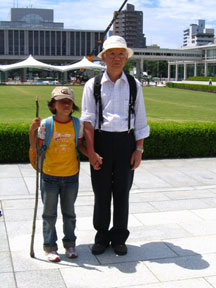The Goals of "Hibakusha, Our Life to Live"
by David Rothauser
"When I went to Tinian Island, I stood on the runway used by the Enola Gay at the airport.
As I stared ahead, I said to myself, 'Taketa, you are wrong ... if you live with hatred,
you can never attain peace in the world.' Revenge after revenge only makes the world uglier,
we will never get peace in that way. I don't want the younger generation to live that way.
It's the adults' responsibility to create a peaceful world for the next generation."
Yasuhiko Taketa
 Yoko and Harada
Yoko and Harada
Early during the production of "Hibakusha, Our Life to Live" a question came to mind, "What are my goals in making this film?" I began listening closely to hibakusha stories.
Each one expressed the same sentiment, "We hope our stories will reach younger generations so nuclear war will never happen again." Another question was, "How can I answer their hopes and wishes?" I soon realized that their unique stories needed connections that would reach younger generations emotionally and intellectually. So I tried to find the most honest and truthful way of telling the story of the atomic bomb attacks on Hiroshima and Nagasaki. More questions came to me.
What was the context of this great terror? Obviously it was World War II. How did WWII affect the lives of adults and children in Japan and the U.S.? The answers came quickly. As a child growing up in America during WWII, I had some frame of reference. But was it true? Much of my experience then was based on scientific secrecy and propaganda. I learned my lessons from Hollywood movies. War was a game that I enjoyed playing. How about Japanese children? Their experience before WWII was based on secrecy and propaganda. They too played war games. By including my own experience in the film I found the key to the truth behind the development and use of atomic bombs on Japan. Hibakusha stories became my story as well. I found that I could best tell hibakusha stories by including many elements — a sort of family tree — that would help younger generations understand what happened in 1945 and what it means for them today and in the future.
Following the dropping of atomic bombs on Japan, I became keenly aware that the world I was living in had changed forever. In a strange way the A-bomb had united all humans world-wide in a common denominator of survival – SURVIVAL UNDER A NUCLEAR CLOUD. I began assembling the many elements that I felt would tell this story with power and meaning. In viewing the film you (the audience) will see changes from one tense to another. For example, in the film, the bombing of Hiroshima takes place during the 60th Anniversary arts festival in Peace Park. It is a way of showing younger generations that nuclear warfare is possible at any moment of the present and future. The bombing of Nagasaki is shown from the perspective of a Shinto wedding ceremony. The effect is intimate and haunting. The story of Yoko, the little girl who travels to Hiroshima with Harada-san, is to show the link between the younger and older generation and to show how their activities together have helped in the education of younger generations about nuclear war.
I had three dreams. One was to make the film. The second is to take the film on a world tour where audiences will be engaged in discussions about nuclear war and the abolition of nuclear weapons. The third dream in showing the film is to open up the possibility for a global Article Nine to prevent not only nuclear wars, but all future wars beyond the defense of one’s homeland.
Life is a precious gift. May we live it without fear.

Art by Japanese atomic bomb survivors reproduced courtesy of the Hiroshima Peace Memorial Museum and by the artists. From left to right: Yoshio Hamada, Susumu Horikoshi, Takako Tsujioka, Sumiko Yamada, Mikio Inoue, Haruo Harada.
Memory Productions • 90 Boylston Street #1 • Chestnut Hill, MA 02467 • 617 332-5014
Site design by June Santosa